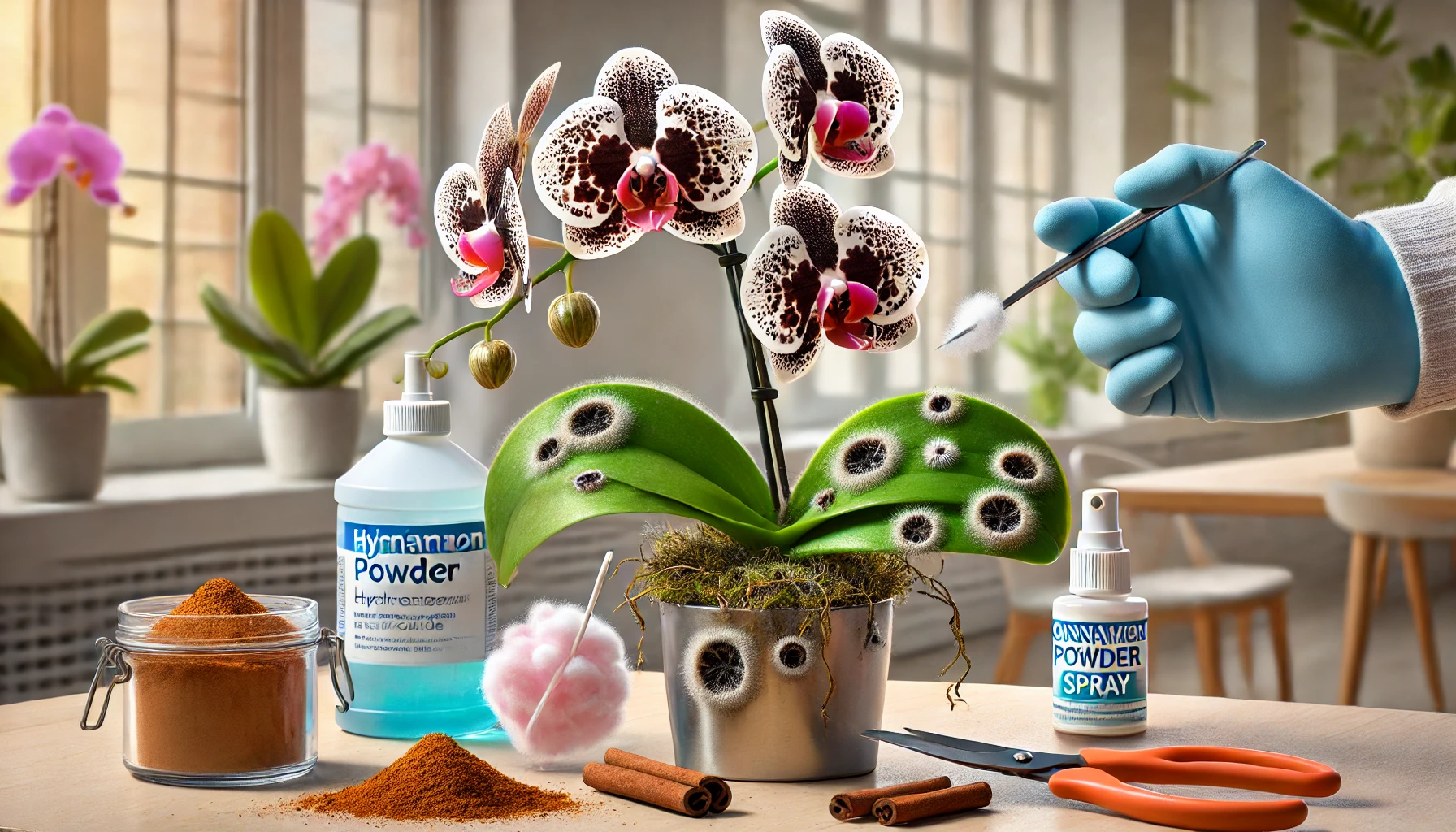Orchids are resilient plants, but they can still fall victim to fungal and bacterial infections if their environment becomes too humid, poorly ventilated, or overwatered. These infections can cause leaf spots, root rot, and wilting, which, if untreated, may weaken or even kill the plant. Learning how to identify early symptoms and apply the right treatments will help keep your orchid healthy and thriving.
🌱 Why Do Orchids Get Infections?
Fungal and bacterial infections develop when orchids are exposed to excess moisture, stagnant air, or contaminated surfaces.
✔ Common Causes of Orchid Infections:
- Overwatering – Excess water leads to root rot and fungal growth.
- High humidity with poor airflow – Creates a damp environment where mold and bacteria thrive.
- Dirty pots, tools, or hands – Can spread bacteria and fungal spores to the plant.
- Water left on leaves or crown – Can lead to crown rot or bacterial spotting.
- Old or decaying potting mix – Becomes a breeding ground for harmful fungi.
💡 Prevention is key—keeping orchids clean, well-ventilated, and properly watered helps avoid infections.
🦠 Common Orchid Fungal Infections
Fungal infections usually develop in warm, moist conditions and spread through spores. They affect leaves, roots, and sometimes even flowers.
✔ 1. Black Rot (Pythium or Phytophthora Fungus)
- Symptoms: Dark black or brown spots on leaves, often spreading quickly.
- Causes: Overwatering, high humidity, poor air circulation.
- Treatment:
- Trim infected areas with sterilized scissors.
- Apply cinnamon powder or a fungicide on the cut edges.
- Improve air circulation and avoid getting water on leaves.
✔ 2. Powdery Mildew
- Symptoms: A white, powdery coating on leaves and stems.
- Causes: High humidity, lack of airflow.
- Treatment:
- Wipe off mildew with a damp cloth.
- Spray with a mixture of one part milk to two parts water (a natural antifungal).
- Increase airflow around the plant.
✔ 3. Botrytis (Flower Spot Fungus)
- Symptoms: Small brown or black spots on flowers.
- Causes: Cool, damp conditions with poor airflow.
- Treatment:
- Remove affected flowers and increase ventilation.
- Keep orchids in a warmer, drier spot.
- Avoid misting flowers directly.
💡 Fungal infections spread quickly—isolating an infected orchid prevents it from affecting other plants.
🦠 Common Orchid Bacterial Infections
Bacterial infections develop when orchids experience wounds, stagnant moisture, or poor sanitation. These infections often have a foul smell and spread faster than fungal infections.
✔ 1. Bacterial Brown Spot (Pseudomonas Bacteria)
- Symptoms: Soft, watery brown patches on leaves.
- Causes: Water left sitting on leaves after watering.
- Treatment:
- Cut off infected tissue with sterilized scissors.
- Wipe the wound with hydrogen peroxide (3%) or cinnamon powder.
- Avoid misting leaves and improve air circulation.
✔ 2. Crown Rot (Erwinia Bacteria)
- Symptoms: Dark, mushy rot at the center (crown) of the orchid.
- Causes: Water pooling in the crown after watering.
- Treatment:
- Tilt the orchid to drain water from the crown.
- Remove affected tissue and apply cinnamon or fungicide.
- Keep the plant in a warm, dry area to recover.
💡 Bacterial infections spread faster than fungal ones—treat them immediately to prevent severe damage.
🚨 How to Tell the Difference Between Fungal and Bacterial Infections
It can be tricky to determine whether your orchid has a fungal or bacterial infection. Here are some key differences:
✔ Fungal infections:
- Often appear as dry spots or powdery coatings.
- Develop slowly over time.
- Can be treated with fungicides and airflow improvements.
✔ Bacterial infections:
- Appear as soft, mushy, and sometimes smelly areas.
- Spread rapidly, sometimes within a few days.
- Need immediate cutting, disinfection, and drying to stop the spread.
💡 If you’re unsure, start by removing affected areas, improving airflow, and avoiding excess moisture—this helps with both types of infections.
🛑 Step-by-Step Guide to Treating an Infected Orchid
If you notice signs of infection, act quickly to prevent further damage.
✔ Step 1: Isolate the Orchid
- Move the infected orchid away from other plants to prevent the spread.
✔ Step 2: Trim the Affected Areas
- Use sterilized scissors to remove infected leaves, roots, or flowers.
- Disinfect scissors after each cut to avoid spreading the infection.
✔ Step 3: Disinfect the Wounds
- Apply cinnamon powder (a natural antifungal) to the cuts.
- For bacterial infections, use hydrogen peroxide (3%) to clean the area.
✔ Step 4: Improve Airflow and Reduce Humidity
- Increase ventilation with a small fan or open window.
- Avoid misting the leaves to prevent excess moisture buildup.
✔ Step 5: Adjust Watering Habits
- Water only at the base—avoid getting water on leaves or the crown.
- Water in the morning so the plant dries out by night.
💡 Orchids are resilient—if caught early, infections can be stopped before they cause major harm.
🚫 Common Mistakes That Worsen Orchid Infections
❌ Ignoring the first signs of infection – Waiting too long allows the disease to spread.
❌ Overwatering an infected orchid – Makes bacterial and fungal problems worse.
❌ Using unsterilized tools – Can spread bacteria or fungi from plant to plant.
❌ Keeping orchids too close together – Encourages disease transfer.
🛡 How to Prevent Orchid Infections in the Future
✔ Keep orchids in a well-ventilated area to reduce moisture buildup.
✔ Always water at the base—avoid wetting leaves and flowers.
✔ Sanitize tools and pots regularly to prevent contamination.
✔ Repot orchids every 1–2 years to refresh the potting mix and prevent decay.
✔ Check orchids weekly for early signs of disease, catching problems before they spread.
By identifying fungal and bacterial infections early and applying the right treatments, you can save your orchid from serious damage and ensure it continues to thrive! 🌸✨
